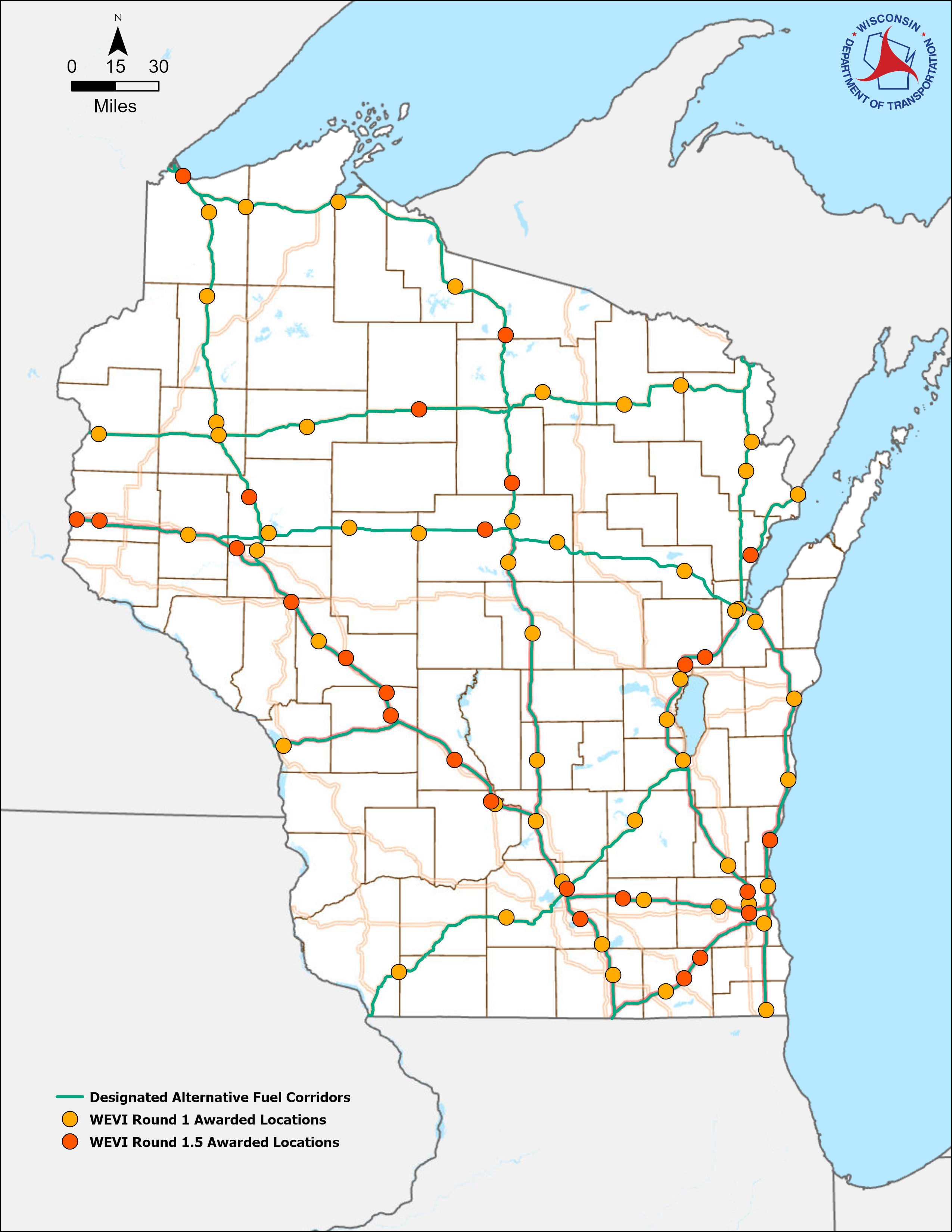On February 6, 2025, the U.S. Department of Transportation (US DOT) notified all state DOTs that NEVI Formula Program Guidance (most recently updated on June 11, 2024) and any previously approved state electric vehicle infrastructure plans (including Wisconsin’s most recent plan approved on November 15, 2024) were rescinded.
On June 24, a federal judge issued a preliminary injunction ordering the release of NEVI funding.
With the federal pause on NEVI funding lifted, the State of Wisconsin resumed accepting applications under the Wisconsin Electric Vehicle Infrastructure (WEVI) Round 1.5 until its deadline of September 5, 2025, at 5 p.m. CT. Consequently, the WEVI Round 1.5 Request for Proposals (RFP) document and the Round 1.5 Submission Packet issued on October 14, 2024, have been revised and reissued. These documents contain all the information needed for interested applicants to apply to Round 1.5 of the WEVI Program. These documents can be accessed below.


This RFP is final. WisDOT reserves the right to modify the RFP document and the awarding process. To fully utilize the fillable features of this submission packet, please download the submission package and open it in Adobe Acrobat. Applicants could also update and resubmit proposals that were submitted before the federal funding pause.
Round 1.5 of the WEVI Program focuses on building out the remaining gaps in Wisconsin's Alternative Fuel Corridor system to achieve fully-built out status. The
Evaluation Zones and Priority Locations Interactive Map provided information for potential applicants on the 13 coverage gaps that WisDOT was looking to fill in Round 1.5.
WisDOT also considered project applications that met the program's requirements, even if they were not located in the specified evaluation zones but were situated along one of the state’s Alternative Fuel Corridors.
Questions and Answers (Q&A) Document
WisDOT offered two comment periods after the initial release of the WEVI Round 1.5 RFP for prospective applicants to receive clarity on elements of the program. Responses to those comments have been compiled into a
Questions & Answers (Q&A) document. This Q&A document has been updated to reflect the revised and reissued WEVI Round 1.5 RFP and the associated submission packet. Any general or RFP-specific questions can be sent to
TransportationElectrification@dot.wi.gov. When submitting questions regarding the RFP, please include "WEVI Round 1.5 RFP Question" in the subject line. The Q&A document will be updated periodically; however, the Department cannot guarantee that all questions will be answered before the application closing date of September 5, 2025.
Informational Public Webinar
WisDOT hosted a webinar regarding Round 1.5 of the WEVI Program and RFP on Thursday, November 7th, 2024, at 1:00 pm Central Time. During the webinar, WisDOT reviewed the Round 1.5 RFP, provide instructions to proposers regarding the RFP application process and answered program and technical questions.
A recording of the webinar can be accessed
here. Slides from the webinar can be found below.
Any questions asked in the webinar regarding the WEVI Round 1.5 Request for Proposals can be found in the Q&A Document.

Round 1.5 Information Webinar Slides
Round 1.5 Results
Twenty-six locations have been awarded approximately $14 million in federal funds through Round 1.5 of the (WEVI Program. A map of the awarded locations and the related news release can be accessed below.

WEVI Round 1.5 Awarded Locations
Of the 26 site locations, 7 are situated in the Northwest and Southwest Regions, 5 in the Southeast Region, 4 in the North Central Region, and 3 in the Northeast Region. Round 1.5 of the WEVI Program continues its Round 1 goal of prioritizing an equitable distribution throughout the state.
The 26 selected sites features various elements to ensure a satisfactory charging experience. While the NEVI Program requires a minimum of four CCS connectors at each station, 25 of the selected sites also include NACS connectors in addition to their CCS connectors. The NEVI Program requirements also requires a minimum of 150 kW per port, with each station hosting at least four ports. Over 23% of awarded locations exceed the minimum port requirement of 150 kW. Additionally, 88% of the Round 1.5 WEVI sites indicate that future expansion of the charging stations is possible.
Some additional amenities at these sites include pull-through parking at 20 locations, while 22 of the Round 1.5 WEVI sites have adjacent businesses open 24/7.
WEVI charging stations utilize various charging station models, including Autel, Gilbarco, SK Signet, Tellus Power Green, Tesla, Tritium, and ZEF Energy.
If you have any questions regarding the awarded locations selected in this round of funding, please refer to the WEVI Round 1.5 Awarded Locations
Frequently Asked Questions (FAQ) document.
Federal Requirements
The WEVI Program is subject to specific federal requirements. Proposers are required to complete a checklist affirming that the projects and site will comply with the requirements outlined in
23 CFR 680 and applicable laws and terms and conditions outlined on pages 11-13 and Appendix B of the WEVI RFP. These requirements are listed below or in
Section 5.4 of the WEVI 2024 Plan Update.
Federal Law Compliance:
Applicants must also be compliant with applicable Wisconsin Statues and Administrative Transportation codes.
For additional information, visit the tab below for links to WisDOT, state and federal resources.